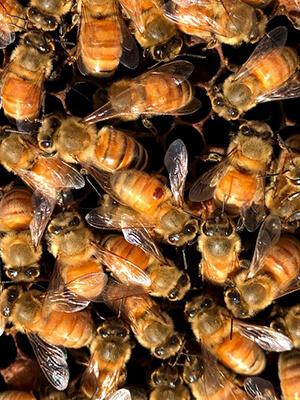
One problem with chemical pesticides is although they work on the bad guys (i.e., the target pests), they also work on the good guys (e.g., the organisms you aren’t trying to harm, such as bees or butterflies). This means using chemical pesticides is a bit of a scorched-earth approach to managing problems. On the one hand, you get rid of the pest. But on the other hand, you might do harm to the organism you’re trying to protect or other non-target organisms.
About 20 years ago, a promising new type of pesticide started to be developed: double-stranded RNA, or dsRNA. These pesticides employ RNA interference (RNAi), which is an ingenious way of getting a pest’s cells to stop making certain things that are critical for it to live. You can think of RNAi as sort of the opposite of the COVID vaccine most of us have taken over the past few months. Instead of the RNA in the COVID vaccine making our bodies do a good thing (build immunity to a deadly disease), the RNAi in a pesticide interferes with a pest’s ability to function, which can ultimately cause the pest to die.
Importantly, RNAi can be very specific to one type of organism (e.g., a single pest species). Therefore, RNAi can function more like a silver bullet than a scorched-earth approach to pest management. Even more exciting, did you know a promising RNAi technology for the varroa mite was developed and patented by Bayer Crop Science five years ago? This raises the possibility that we can control varroa without using synthetic chemicals or acids, each of which places some stress on bees.
But how selective is the RNAi for varroa? Does it only impact varroa, or are there other non-target organisms it also impacts? These are the topics for our forty-fourth Notes from the Lab, where we summarize “Evaluating toxicity of Varroa mite (Varroa destructor)-active dsRNA to monarch butterfly (Danaus plexippus) larvae,” written by Niranjana Krishnan and colleagues and published in the journal PLoS One [2021].
For their study, Krishnan and colleagues started with the observation that the varroa-active dsRNA developed by Bayer has a 21-base pair match to monarch butterfly (Danaus plexippus RNA. Because the varroa-active dsRNA is fed to honey bees via a sucrose feeder in hives, exposure to non-target insects outside the hive is unlikely. But at the same time, scientists think dsRNA has the potential to work if it shares a minimum sequence of 19-21 nucleotides with a target insect. This is within the range of similarity to monarch RNA, which has a 21-base pair match. So, since no beekeeper wants to harm monarch butterflies, and some beekeepers may occasionally be as clumsy as me and spill sucrose in their apiary by accident, the authors decided to look into this topic.
To test whether the varroa-active dsRNA could impact monarchs, Krishnan and colleagues conducted a series of bioassays. Specifically, they reared monarch larvae on one of two milkweed species (the common milkweed, Asclepias syriaca, or the tropical milkweed, A. curassavica) that were coated with the varroa-active dsRNA at two different concentrations (1X or 10X what’s fed to bees), untreated leaves and leaves treated with water as negative controls, and potassium arsenate and monarch-active dsRNA as positive controls. Potassium arsenate is known to be toxic to monarchs, and the monarch-active dsRNA was provided by Bayer as a potential positive control that could specifically target monarchs.
Each bioassay was started when monarch larvae neonates were placed on a treated (or untreated) milkweed leaf and allowed to feed. Leaves were replaced each day until the larva died or pupated (~12-16 days for pupation) and mortality was monitored daily. Larval development rate and pupal weight were monitored as potential sublethal responses. In addition, the concentration of dsRNA was measured on the leaves from each of the dsRNA treatments to confirm the treatments were indeed imposed.
So, what did they find? Did the varroa-active dsRNA have a negative impact on monarch survivorship? No. As seen in Figure 1, the only treatment that significantly reduced monarch survivorship compared to controls was potassium arsenate (red line). In all other treatments (pink: monarch-active dsRNA, green: 1X varroa-active dsRNA, purple: 10X varroa-active dsRNA), there was no difference in survivorship compared to the negative controls (blue: untreated leaves, yellow: water-treated leaves) for monarchs feeding on either milkweed species.
Note: Yes, it’s strange the monarch-active dsRNA didn’t actually impact monarch survival. Because the milkweed leaves were confirmed to have monarch-active dsRNA, this result implies the monarch-active dsRNA is ….


